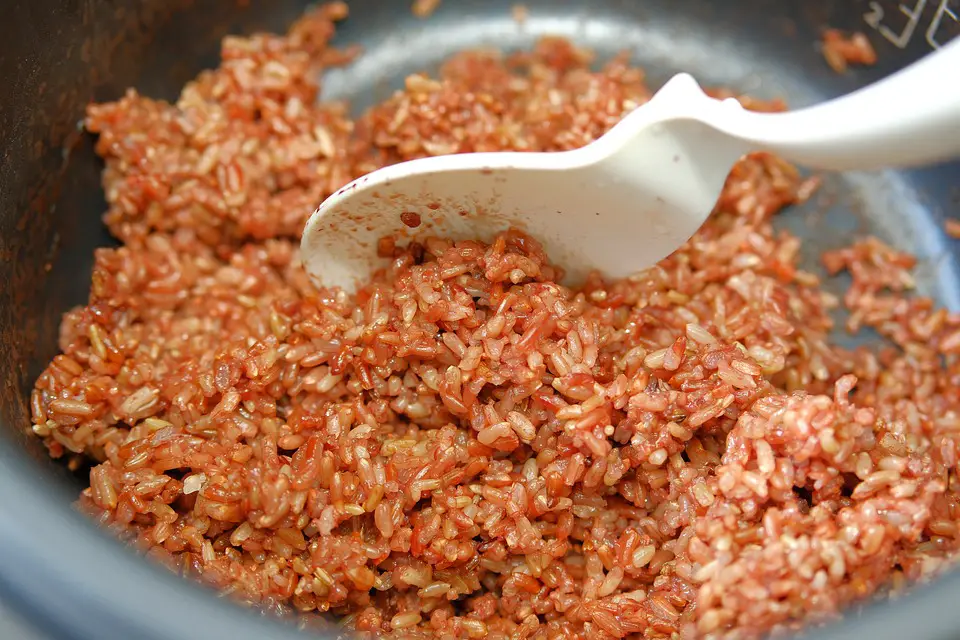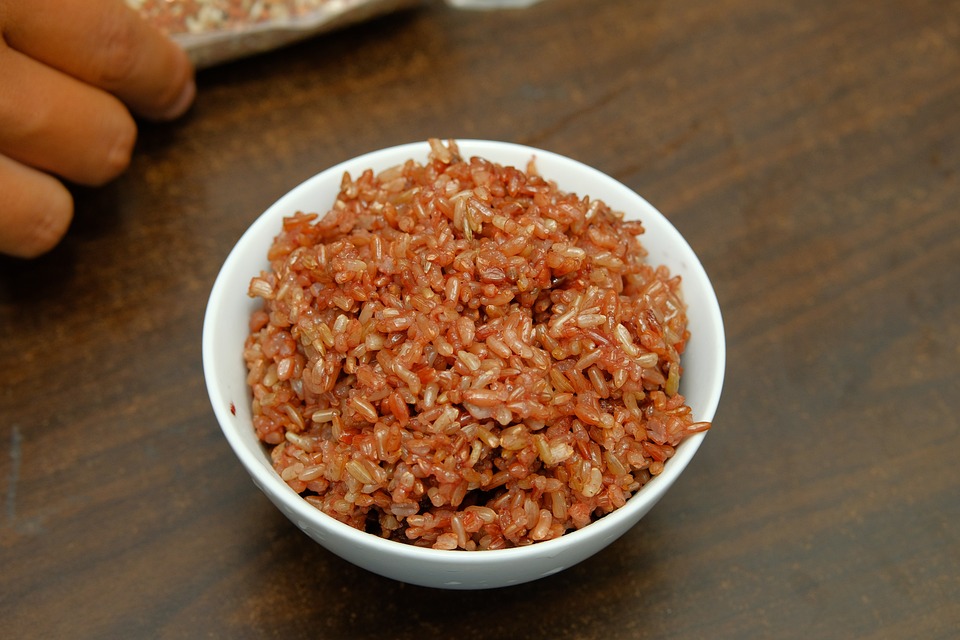The healthy alternative to traditional white rice is brown rice. However, it must remain in good condition if we want to continue enjoying its advantages. We have everything you need to know about brown rice’s shelf life here. We’ll explain how long brown rice keeps fresh, how to extend its shelf life, and how to determine when it should be thrown out. Go on reading.
Keeping cooked brown rice in the fridge can be a challenge. There are so many different things you need to keep in mind. For instance, do you need to store the rice on a shelf or in the refrigerator? Does it need to be at a temperature of 165 degrees Fahrenheit?

What is Brown Rice?
Brown rice is defined as rice that has been de-husked but not polished. The outer layer of the rice kernel, referred to as the hull, is removed to create this type of rice. The nutritious value of brown rice is more successfully preserved by this method. It is more bite-sized and tastes like almonds when compared to white rice.
More than half of the world’s population regularly eats rice. Despite being farmed in more than 100 nations, Asia still produces 90% of the world’s rice. The quality and nutritional value of the more than 110,000 cultivable varieties of rice vary, but rice is either white or brown after harvest.
Rice is a good source of calories, magnesium, phosphorus, manganese, selenium, iron, folic acid, thiamin, and niacin. It has a low fat and fiber content. Brown rice is considered “healthier” than white rice, even though white rice is more frequently consumed. This is because brown rice contains bioactive substances like minerals and vitamins that polished white rice does not.
How Long does Cooked Brown Rice Last in the Fridge?
Different brands of brown rice will give varying directions regarding their product’s shelf life. You may get an indication of how long your rice will maintain its quality by looking at the date on the packaging. However, under optimum conditions, brown rice should last for five to six months. Contrarily, the white counterpart will live up to two years and have a significantly longer lifespan.
Once cooked, the rice keeps well for five to seven days in the fridge and three to five months in the freezer.
Throw away any cooked rice that has been spent the night outside. Rice that has been cooked shouldn’t be kept there. Why? Uncooked rice frequently includes Bacillus cereus spores, which can cause food poisoning and continue to grow in cooked rice. Your rice will quickly become bad since this bacteria grows swiftly at room temperature, produces toxins, and produces toxins.
How to Store Brown Rice?
Brown rice doesn’t often last very long, but with the right storage techniques, you can extend the shelf life of that packet by a few months. Use the following advice to guarantee that your rice stays fresh for as long as possible.
Shop Savvy
Buying fresh brown rice right away is the best method to prevent it from getting rancid too soon. Buying rice in bulk can save you money, but you never know how long the rice has been sitting out. It might already be stale, which would shorten its useful shelf life once you bring it home.
Instead, get the pre-packaged rice, and if possible, stay away from those large sacks. To avoid wasting rice, purchasing it in smaller quantities is preferable.
Brown Rice should be Kept in an Airtight Container.
Put the brown rice in an airtight mason jar when you get home. The aim is to keep it well packed to prevent the oils inside from coming into contact with oxygen, which is the main cause of rancidity in brown rice.
Do Not Use the Pantry
If Possible Brown rice needs to be kept in a cold, dark environment. The rice will keep perfectly well for a long time if properly wrapped and stored in a cold, dark cupboard.
What is the Correct Method of Freezing Cooked Brown Rice?
Rice can be cooled by drenching a sheet pan in water and shaking off the extra. (The rice won’t stick because of the wetness.) Spread the rice out evenly after scooping it into the pan. Allow rice to cool for ten minutes or until it is no longer hot to the touch.
Rice portioning: Divide the rice into the desired serving size using a measuring cup if you want to monitor portion size closely. Pouring water into the cup will wet it, preventing the rice from sticking. Rice should be added to the measuring cup and then transferred to a quart-size freezer bag. Spread and flatten the rice with your hands to create an even layer in the bag, then seal it up by pressing out as much air as possible. If the rice begins to adhere to the cup, rewet it. Repeat with the remaining rice. Repetition is key.
Rice should be frozen after two hours in the freezer, so arrange the filled freezer bags on a clean sheet pan in flat stacks.
Put the frozen rice bags into one or more gallon-size freezer bags and label them with the date and contents for easier storage. For up to three months, keep in the freezer.
Rice should be reheated by transferring it to a microwave-safe container, covering it, and heating it for one minute at a time on full power until it is hot. Before reheating, the rice doesn’t need to be thawed.
How is Brown Rice Cooked?
If it is not fast or quick-cooking, brown rice will work in this straightforward technique. These products will take longer to prepare than plain brown rice because they have undergone more processing. When you’re ready to cook, perform the following actions:
First, rinse the rice. Extra starches on the outside of the rice must be removed to prevent the rice from clumping and becoming sticky as it cooks. If you want to produce perfectly fluffy brown rice, don’t skip this step! I pass the water over mine in a fine-mesh screen until the water is clean.
Next, ascertain the ideal water-to-rice ratio. I use two cups of water for every cup of rice.
Add a teaspoon of extra virgin olive oil to the rice and water in a medium pot.
Time to start cooking now! When the water is boiling, turn the heat down to low, cover the pot, and simmer the rice for 45 minutes or until it is tender and the liquid has been absorbed.
Turn off the heat, last but not least. Before taking off the lid and fluffing with a fork, give the pot 10 minutes to sit covered.
How to Tell that Brown Rice has Gone Bad?
Following are warning signs that your rice has gone bad or is not fit to eat:
Pests that live in the kitchen. It should be thrown away if any of those objects end up in the bag. Of course, unless you don’t mind a little more protein in your rice. Putting jokes aside, discard the bag and look for bugs in surrounding food items. The spread of those things was rapid.
Mold: You probably don’t need me to tell you what to do if there are any, though.
Water or dampness. Both types cause mold to appear within a few days, and you are unaware how far it has spread. Take it away.
Sour odor: A relatively excellent indicator that the rice is bad is any sour, moldy, or “strange” scent.
It is rancid if the rice is brown and smells harsh or like old paint (or makes you think of some other chemicals). Once more, throw it away.
You should adhere to appropriate storage procedures to reduce the likelihood of any of the events above. I am talking about those now.
What will Happen if you Eat Spoiled Brown Rice?
According to the National Health Service of the United Kingdom, reheating rice has been linked to food illness. Bacterial spores that could induce diarrhea and vomiting have been found in rice. According to NHS, the likelihood that bacteria or toxins will make cooked rice dangerous to eat increases the longer it is left at room temperature. You risk getting food poisoning if you ignore the warnings and eat more than a week-old rice.
In addition, the NHS advises that you should serve rice right away after cooking it, put it in the refrigerator within an hour of cooking, make sure your rice is “steaming hot all the way through” after reheating, and never reheat rice more than once. According to one study, eating rice that is more than five days old could even be fatal. That doesn’t necessarily mean that consuming rice that is more than a few days old will kill you, but it does mean that you should use caution, be aware of the warning signs, and make sure to store and cook your rice properly.
Reference: White Rice, Brown Rice, and Risk of Type 2 Diabetes in US Men and Women
A higher intake of white rice (5 servings per week vs. 1 per month) was linked to a higher risk of type 2 diabetes after multivariate adjusting for age and other lifestyle and dietary risk factors: pooled relative risk (95% confidence interval [CI]), 1.17. (1.02-1.36). Contrarily, a higher intake of brown rice (two servings per week as opposed to one serving per month) was linked to a lower risk of type 2 diabetes: pooled relative risk, 0.89 (95% CI, 0.81-0.97). We calculated that switching from 50 g/d (uncooked, equal to one-third serving per day) of white rice to the same amount of brown rice was associated with a 16% (95% CI, 9%-21%) lower risk of type 2 diabetes. In contrast, the same switch to whole grains as a group was associated with an overall risk reduction of 12%.
Is Eating Brown Rice Every Day Good for you?
Brown rice is a good source of many necessary nutrients and is heavy in carbohydrates, almost fat-free, and relatively low in calories. The cooked grain contains 220 calories per cup, 45 grams of carbohydrates, 2 grams of fat, and 5 grams of protein. More than 10% of the daily requirements for magnesium, manganese, thiamine, niacin, and vitamin B-6 are also met by a 1-cup portion. In contrast, brown rice is a much better provider of magnesium and fiber than white rice.
Brown rice is a nutritional powerhouse due to its high fiber content. You require between 20 and 38 grams of fiber daily, depending on your age and gender. Like most Americans, you might be deficient in this crucial essential for promoting good health. Increase your intake of fiber-rich foods like brown rice to enhance digestion and help you feel fuller for longer, which may help you manage your weight.
Additionally, brown rice is a great source of magnesium, providing more than 20% of daily needs. This mineral aids in synthesizing protein protects the health of your nerve endings and aids in blood pressure and blood sugar regulation.
Conclusion
Brown rice is a whole grain. It contains germ and bran, which are not preserved in white rice. Aside from the bran, brown rice also contains natural oils. If not stored properly, these oils can go rancid, which shortens the rice’s shelf life. Have cooked brown rice in your refrigerator or freezer; there are a few ways to ensure you don’t get sick. Leaving the rice out at room temperature increases the risk of bacterial growth. Refrigerator or freezer temperatures will slow down the growth of bacteria.
